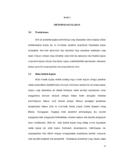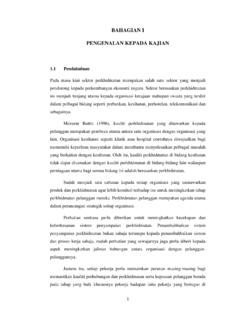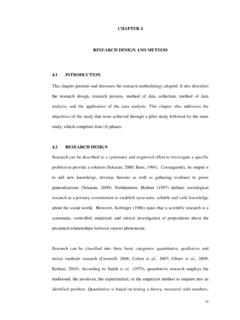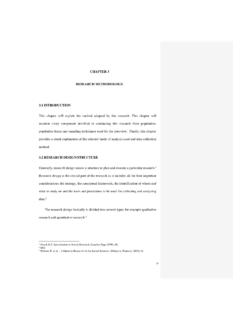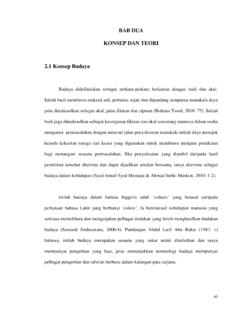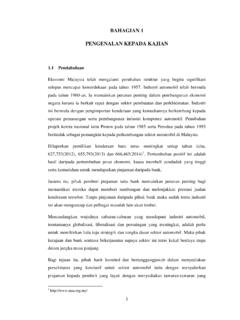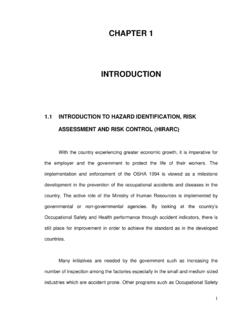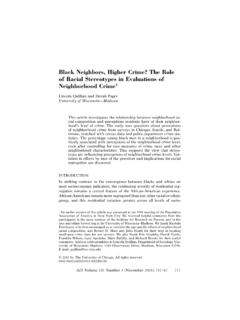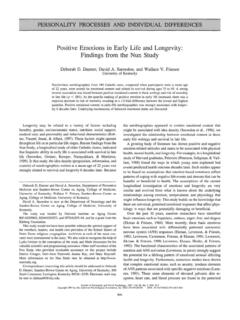Transcription of CHAPTER 1 INTRODUCTION 1.0 Summary
1 1 CHAPTER 1 INTRODUCTION Summary The first CHAPTER of this thesis opens with the background of the study and further describes the field of international entrepreneurship and the internationalization of small and medium enterprises (SMEs) in Malaysia. This is followed by the research objectives, research questions and significance of the study. The CHAPTER concludes with the organization of the thesis. Background of the Study Despite the important role of SMEs as a key contributor in international entrepreneurship, empirical research focusing on Malaysian SMEs in the area of internationalization has been limited. This study attempts to investigate the contributing factors towards internationalization and the performance of SMEs in Malaysia. It originates from the aspiration to contribute to what is known about international entrepreneurship and commitment to improve performance of Malaysian SMEs in international markets.
2 Globalization of the world economy has resulted in the speedy growth and increased interest in international entrepreneurship over the past decade (Brush, 1993, 1995; McDougall et al., 1994; Oviatt and McDougall, 1994, 2005; Hisrich et 2 al., 1996; Hitt and Bartkus, 1997; McDougall and Oviatt, 1995; Busenitz et al., 2003; Zahra and George, 2002; Zahra et al., 2005; Knight and Cavusgil, 1996, 2004, 2005; Keupp and Gassmann, 2009; Hisrich et al., 2010; Coviello et al., 2011). Subsequently, scholars, business people and governments have come to view international entrepreneurship as an important resource for improving the performance of companies and economies, as found by various international entrepreneurship studies. Most of these studies utilize organizational characteristics, environmental factors, factors that determine internationalization and firm strategies as independent variables to explain international entrepreneurship performance (Zahra and George, 2002; Oviatt and McDougall, 1995; Burgel and Murray, 1998; Autio et al.)
3 , 1997; Zahra et al., 2000; Bloodgood et al., 1996; Busenitz et al., 2003; Welch and Welch, 2004; Zahra et al., 2005a; Coombs et al., 2009; Chandra and Coviello, 2010; Naude and Rossouw, 2010; Kiss et al., 2012). The efforts of various scholars to design a well-grounded framework to better understand the nature and effect of international entrepreneurship has, however, largely concentrated on the application of various theoretical perspectives. In essence, they explained this phenomenon by disproving the applicability of traditional frameworks ( , McDougall et al., 1994; Oviatt and McDougall, 1994; Buttriss and Wilkinson, 2006). Moreover, the field of international entrepreneurship is fragmented, inconsistent and lacks common theoretical integration, thus resulting in rather uncertain progress in this field (Keupp and Gassmann, 2009; Coombs et al.
4 , 2009; Jones et al., 2011). Despite being insightful and informative, past research has 3 also raised questions about its overall value due to utilization of different theoretical and methodological traditions. Furthermore, prior research has also lacked a unified framework that connects the antecedents, types, and outcomes of internationalization pursued by new ventures and established companies (McDougall and Oviatt, 2000; McDougall, 1999; Young et al., 2003; Georgiou et al., 2005; Dimitratos and Jones, 2005; Jones and Coviello, 2005; Jones et al., 2011). This area remains largely neglected, thus presenting a major gap in developing a general framework for understanding international entrepreneurship. Despite the progress made in strengthening international entrepreneurship research, important issues remain unresolved due to research limitations or shortcomings (Zahra and George, 2002; Sarasvathy, 2004; Zahra, 2005).
5 For example, most studies have focused on relatively young high technology industries located in developed countries with little emphasis on traditional industries ( , Bloodgood et al., 1996; Autio et al., 2000; Zahra et al., 2000; Busenitz et al., 2000; Bruton et al., 2008; Keupp and Gassmann, 2009; Coombs et al., 2009; Senik et al., 2010; Coviello et al., 2011) while knowledge on international entrepreneurship in emerging economies is limited (Kiss et al., 2012). Most studies have presumed that international entrepreneurship is indicated by simply measuring a firm s international sales revenues (McDougall, 1989; McDougall and Oviatt, 1996; Bloodgood et al., 1996; Reuber and Fischer, 1997; 4 Roberts and Senturia, 1996). Past studies also made conclusions based on case studies or a small sample of respondents (Autio et al.)
6 , 2000; Bloodgood et al., 1996; McDougall and Oviatt, 1996; Tiessen and Merrilees, 1999; Coviello and Jones, 2004; Chelliah and Sulaiman, 2010). To date, international entrepreneurship studies have contributed a large pool of manufacturing and high-technology studies for comparative examination but there is a lack of service sector research or comparative research within and across sectors (Coviello and Jones, 2004). Few studies have examined service industries (Erramillia and D Souza, 1993; Moblang, 1995; Abdul-Aziz and Wong, 2010) which remain historically understudied (Erramilli, 1990, 1992; Clark et al., 1996; Chadee and Mattsson, 1998; Clark and Rajaratnam, 1999; Samiee, 1999; Davis, 2004). Knowledge about particular organizations is also relatively new and limited (Samiee, 1999), with the agribusiness sector being much neglected by researchers (Crick and Chaudhry, 2000; Kevin, 2005).
7 This research explores three main industries; manufacturing, service and agriculture, consistent with recommendations in the literature for greater diversity in the industry scope (Zahra et al., 1999) in the emerging economies, with the specific intention of assessing whether theoretical perspectives developed in mature market contexts are valid in emerging economies (Bruton et al., 2008; Shenkar and Von Glinow, 1994). By exploring a variety of industry contexts, international 5 entrepreneurship scholars can enhance understanding of the links between industry level variables and internationalization patterns, as well as contribute to theories that may be generalized to a greater range of economic sectors (Zahra and George, 2002). In recent years, researchers have become increasingly interested in the performance outcomes of internationalization among small firms (Fahy, 2002; Majocchi and Zucchella, 2003; Westhead et al.)
8 , 2001; Dimitratos et al., 2004; Lu and Beamish, 2006; Aspelund et al., 2007; Coombs et al., 2009; Keupp and Gassmann, 2009; Chandra and Coviello, 2010; Chelliah and Sulaiman, 2010; Kiss et al., 2012). The effects of a firm s financial status on its internationalization have become a research interest. The four elements of a new venture s financial status examined in past research include Return on Equity (ROE), Return on Assets (ROA), Growth of Sales and debt leverage (Zahra et al., 2000; Baum et al., 2005; Greve, 2003; Lu and Beamish, 2006; Grant, 1987; Siddharthan and Lall, 1982; Bloodgood et al., 1996). Yet, financial performance may not be the major indicator to explain the internationalization of a new venture s sales. Some of these new ventures most likely expand internationally as a means of achieving a variety of strategic goals.
9 Moreover, several studies have related international entrepreneurship to non-financial performance. Oviatt and McDougall (1995, 2005a) connected internationalization to market share and competitive advantage while Zahra et al. (2000) have related internationalization to technological learning and acquisition of 6 new knowledge. To achieve better results and justify the outcomes of internationalization, this study used both financial and non financial performance. Strategic management and entrepreneurship researchers have recognized the importance of the external environment on firms various strategic choices (Boyd et al., 1993; Zahra et al., 1997; Preece et al., 1999; Zahra and Bogner, 2000; Jones and Coviello, 2005; Oviatt and McDougall, 2005; Szyliowicz and Galvin, 2010).
10 McDougall (1989) found that international new ventures competed in industries that exhibited significantly higher levels of government protection and regulations, thus confirming that reputation as an important strategic asset (Fomburn, 1994; Hall, 1993), particularly for young entrepreneurial companies (Bell and McNamara, 1991). A favorable reputation, constructive support, connection to powerful and established networks and other invisible assets can greatly influence the ways companies proceed to position themselves (Itami and Roehl, 1987), especially in international markets. In fact, Van De Van (1993), Mohd (2005), Arowomole (2000) and Kuratko et al. (2004) suggested that external factors predict and significantly affect entrepreneurial performance. Van De Van (1993) further suggested that studies within the field of entrepreneurship development that do not consider the external environment should be considered incomplete and invalid.

